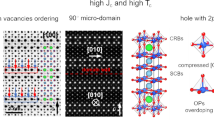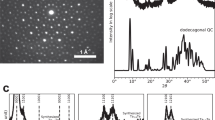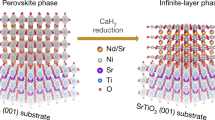Abstract
Oxide superconductors in the system Tl2Ba2Can–1CunO4+2n (ref. 1) have transition temperatures (Tc) above 100 K, increasing with n. So far, stacking sequences up to n = 3 have been found in small crystals, and sequences with n > 3 have been seen in electron microscopy studies1. For large n, the stoichiometry of Tl2Ba2Can–1CunO4+2n approaches CaCuO2, a structure expected to consist only of CuO2 planes separated by Ca atoms. By analogy with Tl2Ba2Can–1CunO4+2n, the unit cell of this hypothetical phase is expected to be tetragonal with a = 3.86 Å. Such a compound is not known in the Ca–Cu–O system, but Roth2 recently reported that small amounts of Sr on the Ca site can stabilize this simple structure. Here we report the growth of small single crystals of this phase, with composition (Ca0.86Sr0.14)CuO2, and their characterization by single-crystal X-ray diffraction. The crystals are tetragonal with space group P4/mmm, and the structure contains planar [CuO2]∞ layers separated by Ca and Sr atoms. The structure is a simple defect perovskite with ordered oxygen vacancies and can be regarded as the n = ∞ parent of the A2B2Can–1CunO4+2n (A = Bi, Tl; B = Sr, Ba) superconductors.
This is a preview of subscription content, access via your institution
Access options
Subscribe to this journal
Receive 51 print issues and online access
$199.00 per year
only $3.90 per issue
Buy this article
- Purchase on Springer Link
- Instant access to full article PDF
Prices may be subject to local taxes which are calculated during checkout
Similar content being viewed by others
References
Torardi, C. C. et al. Science 240, 632–633 (1988).
Roth, R. S. Am. Phys. Soc. Meeting, New Orleans (1988).
Gabe, E. J., Lee, F. L. & Le Page, Y. in Cryststallographic Computing Vol. 3 (ed. Sheldrick, G. H., Krüger, C. & Goddard, R.) 167–174 (Clarendon, Oxford, 1985).
Müller-Buschbaum, H.-K. & Wollschläger, W. Z. Anorg. Allg. Chem. 414, 76–80 (1975).
Gallagher, P. K., O'Brian, H. M., Sunshine, S. A. & Murphy, D. W. Mater. Res. Bull. 22, 995–1006 (1987).
Müller-Buschbaum, H.-K. Angew. Chem. 89, 704–717 (1977).
Le Page, Y. et al. Phys. Rev. B36, 3617–3621 (1987).
Sunshine, S. A. et al. Phys. Rev. B (in the press).
Von Schnering, H. G. et al. Angew. Chem. Int. Ed. Engl. 27, 574–576 (1988).
Tarascon, J. M. et al. Phys. Rev. B (in the press).
Subramanian, M. A. et al. Science 239, 1015–1017 (1988).
Author information
Authors and Affiliations
Rights and permissions
About this article
Cite this article
Siegrist, T., Zahurak, S., Murphy, D. et al. The parent structure of the layered high-temperature superconductors. Nature 334, 231–232 (1988). https://doi.org/10.1038/334231a0
Received:
Accepted:
Issue Date:
DOI: https://doi.org/10.1038/334231a0
This article is cited by
-
Geometric frustration of Jahn–Teller order in the infinite-layer lattice
Nature (2023)
-
Strain-mediated insulator-metal transition in topotactically hydro-reduced SrFeO2
Science China Physics, Mechanics & Astronomy (2021)
-
Spin excitations in nickelate superconductors
Science China Physics, Mechanics & Astronomy (2020)
-
Superconductivity in an infinite-layer nickelate
Nature (2019)
-
Real-Time Evolution of the Electron Clouds of Transition Metal Ions: Possible Electron-Pairing Medium in Unconventional High-Temperature Superconductors
Journal of Superconductivity and Novel Magnetism (2019)
Comments
By submitting a comment you agree to abide by our Terms and Community Guidelines. If you find something abusive or that does not comply with our terms or guidelines please flag it as inappropriate.



